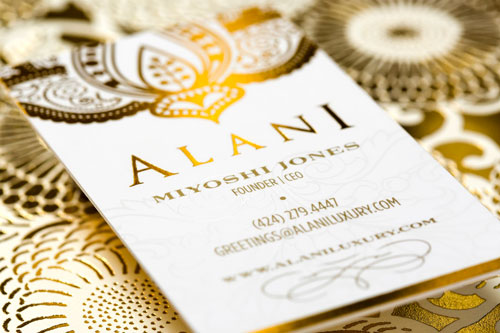
Business cards are highly visual, but smart designers know the power that comes from going beyond looks alone and engaging with touch using paper weight and texture.
Paper weight, touch, and feel are tied into certain cultural expectations, too. Lightweight paper denotes a disposable quality that heavier paper stock does not. People toss newsprint in the recycle bin without a second thought, but may hold onto wedding invites or holiday cards for decades.
Choosing the right paper for your business card can trigger a similar effect. You want to select a paper that your recipient could pull from a pile with their eyes closed.
How do you choose the best business card stock? Here are the basics:
Paper stock, explained
Nearly all paper business cards are made using card stock, though other creative options exist!
Paper weight is measured using a system known as grammage, and stock describes paper weights between 50 and 140 # or lb (no “s”).
Paper weight is a useful metric for understanding the heft of paper — and its quality, in some senses — but it doesn’t give clear insight into thickness.
That’s why card stock business cards are measured in thickness “points.” Each point equals 0.001 inch. The two most common traditional paper stocks for business cards are 14 and 16 point.
What’s a good paper stock?
Traditionally, a lightweight 14 point business card would be used for exposure — cards you leave on a cafe table or hand out at events. 14 point paper is also used for postcards, and brochures as well. 16 point cards are the ones you’d hold onto for more valuable networking encounters.
New technology and evolving trends in print are pushing the limits of card thickness at price points that work for most businesses. In a world where you need to compete for attention with any number of distractions, you need something that will stand out.
Thick cards — 32 point business cards or even 48 point business cards — allow for a variety of edge effects and die cuts that lightweight cards can’t handle. Thick and ultra-thick cards are more rigid and stand up to wear and tear better. Travelers who don’t wish to carry a business card holder with them can opt for heavy stock thick cards and know they’ll come out of a laptop bag or coat pocket looking great.
Of course, the thicker your card is, the higher your expected cost per print run will be. Think about what kind of experience you’re looking to create when pinpointing your print budget and try and find the perfect mix of thickness and budget.
Standard: 16 point ($)

Thick: 32 point total ($$)

Ultra-thick: 48 point total ($$$)

*Depending on the paper you choose, you can also get double layer or triple layer cardstock business cards that match up to a range of thicknesses.
Paper textures
There’s more than one way to create a hefty, impressive card. Silkcards offers several paper finishes that project a strong sense of purpose and value. Some popular choices include:
Silk

Known for their soft and silky touch, silk paper cards are 16 point paper with a matte finish. These business cards can be stacked upon one another to allow for unique layered die-cut effects. Silk is among the more affordable and versatile custom card stock business card options available.
Suede

Suede cards are made using a lamination process that gives them a gentle suede-like touch. Available in 32 and 48 point stock, suede cards are thick and luxurious in every sense.
Cotton

A throwback favorite, cotton paper — often referred to as “letterpress” — is more pillowy and less dense than other paper styles. Cotton paper isn’t a great choice for stacking effects, but it does work well with typeset and logo effects. Cotton paper gives designers a lot of creative license.
What else?

Your creativity isn’t limited to these three options. Silkcards offers cards for all occasions made from plastic, wood, linen paper, and more.
Conclusion
Making your business card stand out from the crowd requires an understanding of how paper creates an experience. Thickness and texture are highly resonant, which makes your card stand out in your recipient’s mind. Once you have the basics in line, your creativity can take the wheel.
Learn more with our Designers’ Ultimate Guide to Printing Unique, Custom Business Cards!

